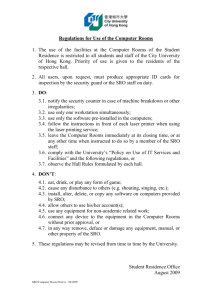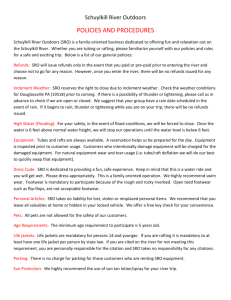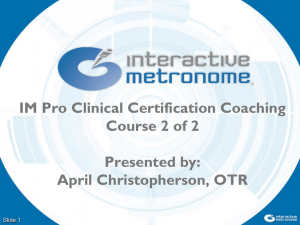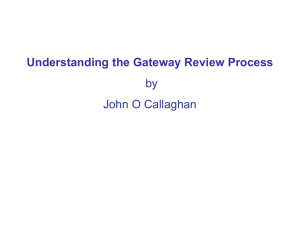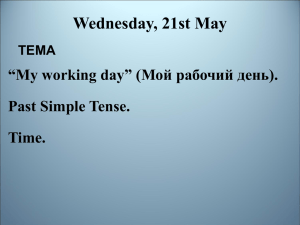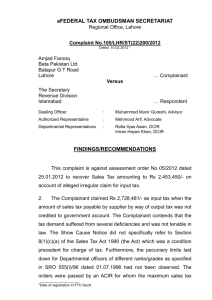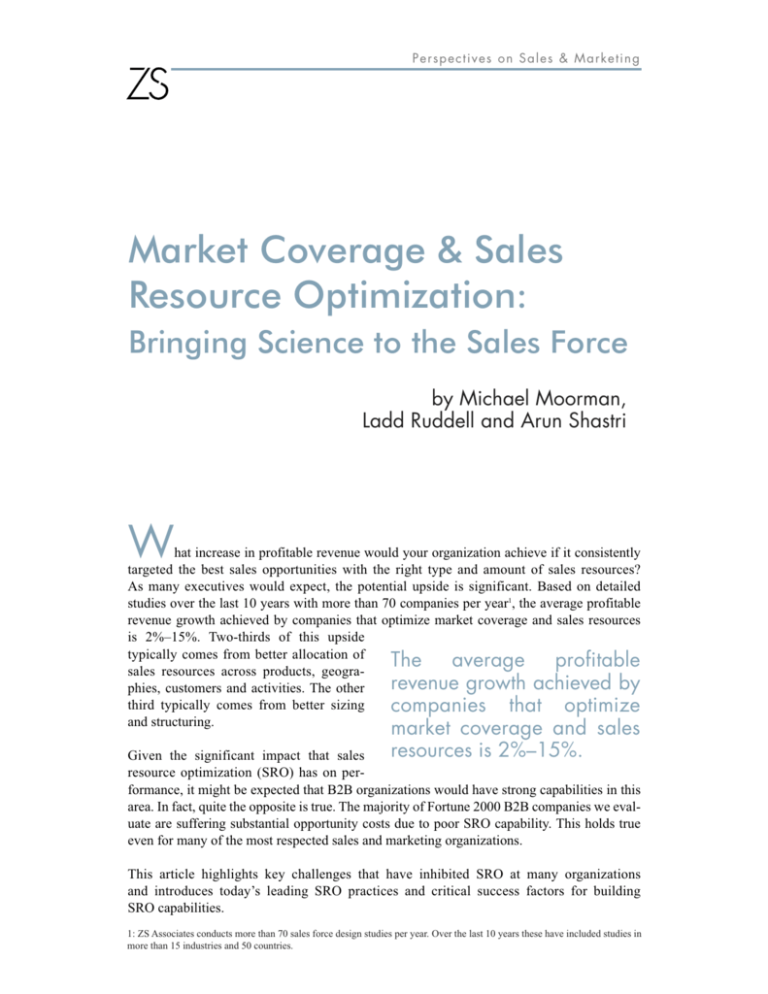
Perspectives on Sales & Marketing
Market Coverage & Sales
Resource Optimization:
Bringing Science to the Sales Force
by Michael Moorman,
Ladd Ruddell and Arun Shastri
W
hat increase in profitable revenue would your organization achieve if it consistently
targeted the best sales opportunities with the right type and amount of sales resources?
As many executives would expect, the potential upside is significant. Based on detailed
studies over the last 10 years with more than 70 companies per year1, the average profitable
revenue growth achieved by companies that optimize market coverage and sales resources
is 2%–15%. Two-thirds of this upside
typically comes from better allocation of
The
average
profitable
sales resources across products, geograrevenue growth achieved by
phies, customers and activities. The other
third typically comes from better sizing
companies that optimize
and structuring.
market coverage and sales
resources is 2%–15%.
Given the significant impact that sales
resource optimization (SRO) has on performance, it might be expected that B2B organizations would have strong capabilities in this
area. In fact, quite the opposite is true. The majority of Fortune 2000 B2B companies we evaluate are suffering substantial opportunity costs due to poor SRO capability. This holds true
even for many of the most respected sales and marketing organizations.
This article highlights key challenges that have inhibited SRO at many organizations
and introduces today’s leading SRO practices and critical success factors for building
SRO capabilities.
1: ZS Associates conducts more than 70 sales force design studies per year. Over the last 10 years these have included studies in
more than 15 industries and 50 countries.
Challenging the Current State
The science of sales resource optimization has advanced dramatically in the past 20 years.
Achieving highly effective SRO capabilities requires a combination of leading business
processes, analytical methodologies, dynamic modeling tools, and people knowledge and
skills.
A number of compounding factors regularly inhibit SRO within many organizations. Some of
the most prevalent include:
1. The move to hybrid sales channel strategies (e.g., combinations of GAM, SAM,
KAM, field sales, specialists, telesales and/or business partners) has significantly
increased the complexity of sales resource planning.
2. Key stakeholders at the line-of-business, product, geography and sales team levels
look first to ensure their own business interests are addressed, versus those of the
larger organization.
3. Maintaining internal expertise in the leading analytical methods and tools for evaluating account potential, estimating sales response to alternative sales coverage, and
modeling optimal sales resources is difficult. Few external resources exist to support
the development of such expertise.
4. Essential account, coverage and productivity data is fragmented within the organization and difficult to integrate and refine. Different data sources exist in different linesof-business and countries.
5. Quality decisions and organizational buy-in require a careful balance between historical data and internal expert estimates (e.g., from sales managers) in the analysis
process. Achieving the right balance requires strong facilitation processes, tools and
validation methods.
Organizations generally fall into one of four SRO capability levels, as shown in Figure 1. The
shortcomings of levels two and three are particularly important given that approximately
70%–90% of companies fall within these two groups.
~5-10%
~35-45%
~35-45%
~5%
LEVEL 2
LEVEL 1
• Relative to last
year
• Financial ratios
LEVEL 3
• Account-level
potential
• Sales judgment
LEVEL 4
• Incremental sales
response
• Bottom-up/top-down
• End-to-end
• Affordability
• Benchmarks
Poor / Misleading
Better
But Insufficient
Optimal
Figure 1. Market Coverage & Sales Resource Optimization Capability Levels
2
ZS Associates
In level two, organizations rely on financial ratios, such as sales-per-rep and affordability, as
a primary driver in their sales resource decisions. While easy to administer, such methods
almost always lead to poor sales resource decisions. Financial ratio and affordability methods
completely fail to identify the account segments that will be most profitable to target, and the
sales effort that will be required to cover the accounts in those segments. They are not able to
estimate the amount or type of sales resource that will be optimal for the company. These
methods create a false sense of security that sales resource decisions have been effectively
linked to financial outcomes.
Sales-per-rep is an especially misused ratio. Sales-per-rep for a given product group can be
high for several reasons:
1. Average sales person effectiveness is high.
2. The team or rep has an especially high concentration of large accounts (note: sales
effort does not scale linearly with account size).
3. The sales force is undersized.
Comparing sales-per-rep between two groups can easily be misleading. Is the West Region’s
sales-per-rep higher than the East’s because they are more effective, because they have a
higher concentration of large accounts, because the sales team in the East is undersized, or
because of some combination of these factors? Cautious, detailed analysis is required to
understand causality for differences in sales-per-rep.
Level three organizations have taken a major step forward by estimating the potential for
each existing and prospect account in their target universe. Methodologies for estimating and
validating account potential have greatly improved and are a major contributor to SRO.
Account potential however, while essential to SRO, is far from sufficient. Sales force effort
does not scale proportionately with potential. For example, a $10M account may not require
10 times the sales effort of a $1M account. Methods that rely on local sales managers to estimate effort are subject to variability in manager skills, and often concentrate effort in those
business areas with the “louder” or “more powerful” stakeholders—which are often not actually where the resources would maximize profitable sales for the company.
Today’s Leading Approaches
Sales resource optimization should be viewed as a business capability comprised of business
processes, data and analytical methodologies, IT tools, and people skills and roles.
Effective SRO requires a business process that is “bottom-up/top-down” and “end-to-end.”
Figure 2 illustrates the business process adopted by level four organizations.
Market Coverage and Sales Resource Optimization: Bringing Science to the Sales Force
3
Account
Account Potentialization
Potentialization
&
& Growth
Growth Opportunities
Opportunities
Products/Segments
Forecasts
High
A&P
Sales & Support
Channels
Sales Opportunity
Portfolio
Portfolio Optimization
Optimization
Scenarios
Scenarios
Structure,
Structure, Sizing
Sizing &
&
Resource
Resource Allocation
Allocation
Tactical
Execution
Base Case
Scenario 2
Sales Force Size
Low
Base
2004
SF Effort
2005
Territories
Integrated Targeting
Goals
Size
Contribution
Pricing
Sales
$$$
Product
Strategy
Product
Product Level
Level
Sales
Sales Responses
Responses
Sales/Specialty Teams
Tracking
Performance Mgt
Figure 2. The Bottom-Up/Top-Down, End-to-End SRO Business Process
The SRO business process begins with account level potential and growth analysis. These
inputs support analysis of product-specific resource requirements. Product level requirements
are then integrated into a portfolio-wide view to enable resource optimization at the company
level. Once national level sales resource decisions have been determined, the same account
data and analysis directly drive optimal allocation of resources to regions, territory design,
account targeting and goals setting. The approach is bottom-up/top-down and end-to-end.
The SRO business process integrates marketing and sales planning. It overcomes local advocacy through a fact-based, objective approach, and provides senior leadership with assurance
that the organization is managing sales resource levels and allocation in a way that maximizes
overall performance for the company.
The analytical approach essential for SRO is based on “incremental sales response.” Not all
sales that an organization achieves in a given year are the result of the sales force investment
in that year. Some sales are “carryover” from prior years and will be realized regardless of
sales resource investment. To maximize profitable sales, the sales force investment must be
based on the incremental sales that will be achieved due specifically to the sales force effort.
The future cash flow from these incremental sales must also be considered or the sales force
will be undersized.
Effective SRO establishes the relationship between sales force effort and the incremental
sales and profit that will likely result. This relationship can vary by account segment, product
group, geography and sales channel utilized. By understanding these relationships, sales
resource planners can then, and only then, determine which segments are profitable to cover,
and what type and amount of sales resource will be optimal (Figure 3). Such methods are
essential to SRO and represent a dramatic advancement in SRO capabilities over other
approaches.
4
ZS Associates
Industry
COVERAGE MODELING
Micro-Segment Analysis
$590
• Account potential
$580
• Effort requirements
• Win rates
g io
i n at
u y ent
B ri
O
Potential
• Deal sizes & revenue
streams
n
SALES RESOURCE INSIGHTS
• No effort sales
3yr NPV ($MM)
SEGMENTATION
Worst Case 0%
Incremental ROI = 192
FTEs
$570
$12M
190 FTEs @ 26%
$560
$5M
170 FTEs @ 30%
$550
$540
$530
$520
• Coverage profitability
-
50 100 150 200 250 300 350 400 450
FTEs
Figure 3. Sales Resource Optimization Modeling
The tools that now exist to enable SRO have likewise advanced dramatically. Today’s SRO
tools allow sales resource strategists to dynamically model optimal sales resourcing. They
facilitate the collection of inputs from key stakeholders and experts, and evaluate alternative
sales resource scenarios under varying business constraints. Outputs from these models provide executive decision makers with essential insights, including revenue and profitability
impact at the line-of-business, product and geographic levels associated with different sales
resource options.
The tools to optimize regional and territory deployments have also advanced greatly (Figure
4). Today’s best deployment design tools directly incorporate account-level data and outputs
from SRO sizing and allocation models. By doing so, they enable design of account and geo-
Regional Deployment &
Territory Optimization
(MAPS®)
2,000
Too little sales
resource / high
opportunity cost
Territory Alignment Index
1,800
1,600
Coverage model for the South FL:
RSO
1,400
1,200
CSO
FTF
Tele
FTF
Tele
Product A
1.4
1.4
2.2
0.7
Product B
2.7
0.7
4.1
1.2
Product C
0.3
2.2
0.9
0.4
Product N
0.8
0.4
1.1
1.5
Total
5.2
4.7
Ideal Range
1,000
800
Final
600
Too much sales
resource / high
cost of sales
400
200
Current
0
0
25
50
75
100
125
150
175
Territories
Figure 4. Territory Optimization Software Example
Market Coverage and Sales Resource Optimization: Bringing Science to the Sales Force
5
graphic based territory designs that directly align with the strategy for maximizing return on
sales resource investment. In addition, these tools allow sales resource planners to work with
local sales leaders to refine deployments based on their unique knowledge of local accounts
and markets. Once territories are defined, opportunity-based account targeting and goals can
then be determined for the territories.
Orchestrating the SRO business process and analytical modeling requires that the right stakeholders and experts have input at key points throughout the process. Such input is essential to
both the quality of the answer and the organizational buy-in. SRO requires a central group
that facilitates the process and brings deep expertise and support in modeling. An example
of the people roles and engagement points for a large high-tech company is presented in
Figure 5.
Marketing &
Sales
Analytics
Brand Teams
Sales
Force
Finance
Lead
Consult
Consult
Inform
Manage
Consult
Consult
Consult
Consult
Consult
Lead
Lead
Lead
Lead
Lead
Consult
Consult
Consult
Consult
Consult
Sign-off
Sign-off
Sign-off
Sign-off
Manage
Manage
Manage
Manage
Manage
Product Level Sales
Response
Lead
Consult
Consult
Manage
Portfolio Optimization
Scenarios
Structure, Sizing &
Resource Allocation
Lead
Consult
Consult
Manage
Consult
Consult
Consult
Account
Potentialization &
Growth Opportunities
Sales
Operations
SRO
Manager
Product Strategy
Offerings
Forecasts
SRO Process Steps
Pricing
A&P
Sales Coverage Needs
Sign-off
Lead
Manage
Consult
Lead
Lead
Manage
Manage
Rollout
Territories
Consult
Integrated Targeting &
Call Planning
Consult
Consult
Consult
Lead
Manage
Goals
Consult
Inform
Inform
Inform
20%/Brand
20%/Cust.
Seg
Consult
Inform
Inform
Manage
Manage
10% ea.
0.5
Lead
Lead
10%/Sector
10%/Cust.
Seg.
Tracking
Estimated Headcount
2
1
Figure 5. Example Roles at Each Stage in the SRO Business Process
In some cases organizations already have the essential meetings and interactions in place to
appropriately engage key stakeholders and experts. In these cases, the focus moves more to
what is happening during these interactions and to employing more effective modeling,
analysis and decision-making techniques.
Building SRO Capability
Investments in sales resource optimization capability have the potential to pay significant
returns. For most organizations, sales resource optimization is typically achieved through an
annual sales resource planning exercise and during major events such as sales effectiveness
initiatives, mergers and integrations, new product launches, downsizings, and major
restructurings within the customer universe.
6
ZS Associates
In our experience working with hundreds of organizations to achieve effective SRO capabilities, we have found that:
1. SRO capabilities are best built step-wise rather than simultaneously across business
units, geographies and sales teams.
2. A specific business unit and geography for which SRO will drive significant upside is
typically the best starting point.
3. Methods should be kept as simple as possible without compromising the quality of
decisions.
4. Key stakeholders and subject experts should be engaged throughout the process.
5. Rollout processes and account relationship hand-offs should be managed in a disciplined, proactive way to minimize transition costs.
6. Once the SRO business process, methods, tools and people roles have been piloted,
the SRO capability should then be adapted and rapidly expanded to other parts of the
business.
Conclusions
The pressure to drive organic growth—often with fewer resources—necessitates that today’s
sales and marketing executives ensure the most effective use of sales resources. Getting there
will require that existing approaches be challenged and refined to incorporate leading business processes, analytical methods, tools, and people skills and roles. Leaders in complex
organizations will need to carefully build SRO capability stepwise—starting with a defined,
high opportunity component of the business and then expanding. The benefit realized will be
an objective and disciplined approach that ensures the types, levels and allocations of sales
resources maximize profitable revenue growth company-wide.
Michael Moorman and Ladd Ruddell are Managing Principals with ZS Associates' Chicago
office. Arun Shastri is a Managing Principal with ZS’ Boston office. The authors may be
reached via email at: mike.moorman@zsassociates.com, ladd.ruddell@zsassociates.com
and arun.shastri@zsassociates.com.
Case Studies
Sales resource optimization is a powerful sales effectiveness driver. The following case
examples provide insight to the SRO process and impact.
A leading employee benefits insurance company
The company sells life, disability and dental insurance products to employers and employees in
small- to medium-size markets. The company has maintained two sales teams—one selling
employer-paid products, the other selling employee-paid or voluntary products. New premium
growth had been declining for two years.
SRO identified the need to add sales people in 10 markets and to redirect sales people from saturated
markets toward markets and brokers with high sales potential. Each sales manager developed local
market and segment strategies to drive growth. Finally, key performance metrics and a sales “dashboard” were created to track all levels of the sales organization.
Market Coverage and Sales Resource Optimization: Bringing Science to the Sales Force
7
With more efficient market coverage, the company is on track to gain 25% quote activity per rep and
to increase sales by 20% through deeper reach into markets. Sales rep retention is also expected to
improve since the quality of territories and individual earning opportunity has been greatly
improved.
A leading biotech manufacturer
A leading multi-billion dollar biotech manufacturer was able to realize significant cost savings—
without sacrificing sales results—by optimizing its sales resources. The need for change arose when
the company learned that the development of new products, which were expected to generate more
than 70% of future growth, was delayed by 18 to 24 months. To meet its profit goals, the company
needed to cut more than $300 million annually from its marketing and sales budget.
In an initial diagnostic to identify cost savings, SRO was identified as a significant opportunity. The
new SRO model linked marketing and sales spend to sales results; cost-saving ideas were prioritized.
Decisions were made to collapse some product and industry verticals and support them with fewer
product specialists. They also were able to optimize the way resources were allocated against opportunity and to shift transaction customers to lower-cost channels.
The impact was dramatic. The company’s share price increased more than 33% in the two years following adoption of SRO processes. They were able to cut more than $40 million in future headcount
and marketing program spend because of the SRO work stream. Product sales goals were exceeded
by 5 to 50%.
A leading distributor of high-tech hardware and software products
This Fortune 500 company sells high-tech hardware and software to large, medium and small
account segments. The sales organization is comprised of thousands of face-to-face and inside sales
persons organized by industry and company size. The organization had consistently achieved double
digit growth rates for many years.
Recent slowdowns in growth led executive management to evaluate opportunities to reinvigorate
growth. SRO was identified as a major opportunity. Historically, the sales organization had been
sized and deployed based on sales manager “experience” and simple financial ratios. Furthermore,
highly tenured sales representatives had accumulated large territories over the years that they closely
guarded.
Sales resource levels, allocation by market segment, and territory assignments were not enabling
maximum growth in profitable sales. The sales organization was significantly undersized. Current
sales persons were consumed with servicing existing customer demands and had little time for proactive customer penetration and new account acquisition. The territories that tenured reps had built
vastly exceeded their capacity—and highly valuable accounts were going under-covered.
The organization is now in the process of upsizing and redeploying the sales force. Because of relationship disruption and earning opportunity concerns, the transition from current to optimal has been
mapped out in stages. The step-wise approach to SRO has proven to be an effective way to address
customer needs and maintain senior sales rep morale, while aggressively moving the organization to
the market coverage strategy that will maximize financial outcomes.
8
ZS Associates
Boston • Chicago • Evanston • Frankfurt • London
Los Angeles • Milan • New York • Paris • Philadelphia
Princeton • Pune • San Francisco • Tokyo • Toronto
ZS Associates
www.zsassociates.com
inquiry@zsassociates.com
+1 847.492.3602
Copyright ZS Associates 2007 - All Rights Reserved

